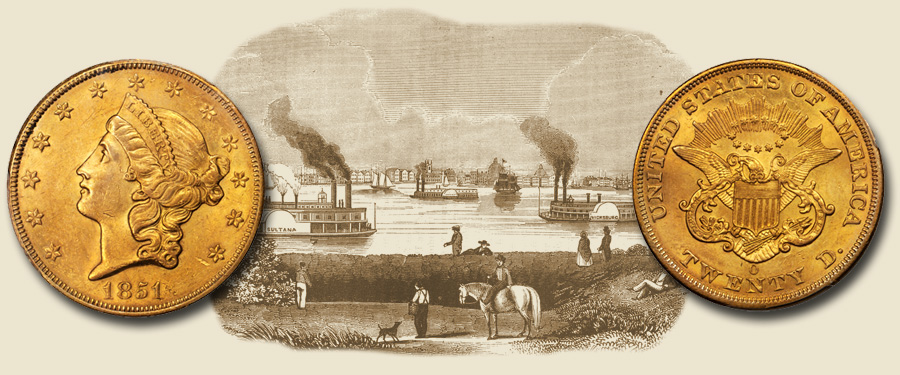
Stack’s Bowers Galleries is pleased to offer an extraordinary, 1851-O Liberty double eagle in our upcoming New York Americana Sale in February. At the Uncirculated threshold, any 1851-O twenty is a prized condition rarity, as virtually the entire mintage of 315,000 pieces entered circulation during those heady days of the California Gold Rush. Today there are a handful of true Mint State coins known; this premium example is tied with eight other grading events for the finest seen by PCGS of this date and mint (duplication is likely within that number).
Gold for coinage at the New Orleans branch mint in 1851 came from a few primary sources. Some of the bullion may have been shipped from as far away as the gold mines of Georgia and the Carolinas, although most of that gold would have been coined locally at either the Dahlonega or Charlotte branch mints. The fees and refining costs varied at the branch mints; competition and local laws also varied from time to time. Much of the gold coined at the New Orleans Mint at this time would have either come from foreign gold coins being turned in for assay or from gold bars or territorial gold pieces coming into New Orleans and being coined into federal gold coins. Ships and gold were arriving from the California gold fields. Any of these diverse sources may have been the source for the gold used in this particular coin.
We can also speculate as to the history of this particular 1851-O double eagle. Perhaps it is one of the ten reported to have been discovered in the "Baltimore Hoard" of gold coins August 31, 1934 by Theodore Jones, age 16, and Henry Grob, age 15. The two youths discovered the hoard hidden in the basement wall of a Baltimore row house located at 132 S. Eden Street. The Baltimore Hoard consisted of $20, $10, $5, $2.50 and $1 gold coins amounting to a face value of nearly $11,200. At first the boys considered turning the gold into the bank, but after 1933 ownership of gold coins was questionable, and the entire fortune was soon turned over to the police. In those days of the Depression such a fortune was an instant media sensation, and before long claimants were as numerous as the coins themselves. Eventually the boys won the majority of the proceeds from the sale of the gold, which realized $20,000 at the time. However, Henry Grob never saw his share of the proceeds as litigation dragged on for years and years and he died from pneumonia in 1937. However, his mother eventually received the proceeds he was due.
Another source of high-grade 1851-O double eagles was the group of 23 pieces found off Santa Barbara in California from the shipwreck of the S.S. Winfield Scott. This ship had stopped over in New Orleans on its way to San Francisco, and was returning south when she ran aground and sunk off the Santa Barbara coast. The gold coins recovered included many important California Fractional gold coins as well as 23 1851-O double eagles. As their location under the sea was shallow, the tides etched the surfaces of virtually all the coins recovered. Despite being technically Mint State, these recovery coins tend to have "sea water" surfaces that are pebbly and not at all lustrous, caused by the tidal forces of sand dragging across their surfaces for decades. This coin is certainly not from that source given the lustrous and appealing surfaces present and high technical grade from PCGS.
Given the years of searching for shipwrecks, random survivors, and the occasional hoard that has surfaced, it remains quite likely that this stunning Mint State-62 coin will stand as one of the finest known of this important New Orleans issue and is destined to be a centerpiece in a landmark collection.





